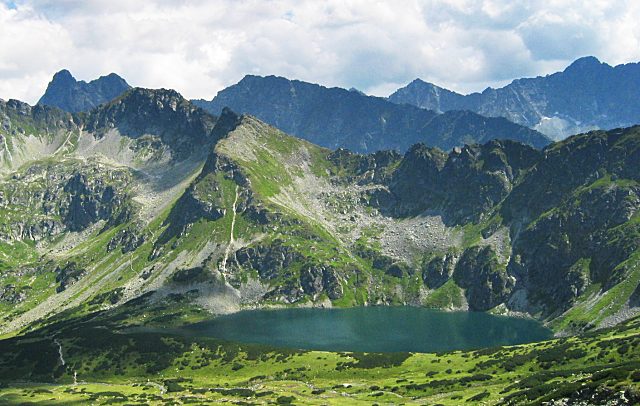Tatra National Park
Tatra National Park (Polish: Tatrzański Park Narodowy; abbr. TPN) is located in the southern part of Poland, by the borders with Slovakia. It was created in 1954 on the area of 215.56 km², but the current area is smaller - 211.64 km². 151.91 km² are forests and 56.60 km² are mainly meadows. Strictly protected are 115.14 km², of which 61.49 km² are forest ecosystems.
First calls for protection of the Tatras appeared at the end of the 19th century. In 1925 first efforts to create a national park, in cooperation with Slovakia, took place. Formally the park was created in 1937, on the area that belonged to the state forests authority. After WW2, in 1947, a separate administrative unit, Tatra Park, was created. And in 1954, with the decision of Polish Government, Tatra National Park was created. In 1993 TPN and its Slovak equivalent with the same name –Tatra National Park (Slovak: Tatranský Národný Park)– became UNESCO’s biosphere preserve of worldwide importance.
The National Park covers the only Alpine mountain range in Poland. The highest peak in Poland, Rysy (2,499 m AMSL), is located here. The Polish Tatra range, which is a part of the Carpathian Mountains, is divided into two parts: High Tatras (Tatry Wysokie) and Western Tatras (Tatry Zachodnie). The landscape consists of sharp-edged peaks and hollows with numerous rock formations. There are around 650 caves, of which the cave system Wielka Sniezna is the longest (18 km) and the deepest (maximum depth 814 m). Six caves of the system are open to public.
Tatra National Park (Polish: Tatrzański Park Narodowy; abbr. TPN) is located in the southern part of Poland, by the borders with Slovakia. It was created in 1954 on the area of 215.56 km², but the current area is smaller - 211.64 km². 151.91 km² are forests and 56.60 km² are mainly meadows. Strictly protected are 115.14 km², of which 61.49 km² are forest ecosystems.
First calls for protection of the Tatras appeared at the end of the 19th century. In 1925 first efforts to create a national park, in cooperation with Slovakia, took place. Formally the park was created in 1937, on the area that belonged to the state forests authority. After WW2, in 1947, a separate administrative unit, Tatra Park, was created. And in 1954, with the decision of Polish Government, Tatra National Park was created. In 1993 TPN and its Slovak equivalent with the same name –Tatra National Park (Slovak: Tatranský Národný Park)– became UNESCO’s biosphere preserve of worldwide importance.
The National Park covers the only Alpine mountain range in Poland. The highest peak in Poland, Rysy (2,499 m AMSL), is located here. The Polish Tatra range, which is a part of the Carpathian Mountains, is divided into two parts: High Tatras (Tatry Wysokie) and Western Tatras (Tatry Zachodnie). The landscape consists of sharp-edged peaks and hollows with numerous rock formations. There are around 650 caves, of which the cave system Wielka Sniezna is the longest (18 km) and the deepest (maximum depth 814 m). Six caves of the system are open to public.
There are several streams and around 30 mountain lakes called staw (pond). These water bodies are an important part of the High Tatra landscape. The largest lakes are: Morskie Oko with an area of 349,000 m² and maximum depth of 50.8 m, and Wielki Staw Polski with an area of 344,000 m² and maximum depth of 79.3 m. Longest streams reach 20 km. Waterfalls, such as Wodogrzmoty Mickiewicza are popular with tourists. The highest waterfall is Wielka Siklawa at 70 m.
Flora
Up to 1,250 m there are mainly fir and beech forests. Higher levels, up to 1,550 m, are covered with spruce forests, which turn into grassland at higher heights, which grows up to 1,800 m. The highest level, above 1,800 m, is of Alpine character.
Fauna
The National Park contains several endemic species and many endangered and protected ones. Animals include: Tatra chamois and marmot, both protected since the mid-19th century, brown bear, Eurasian lynx, wolf, otter, eagle, and falcon.
Up to 1,250 m there are mainly fir and beech forests. Higher levels, up to 1,550 m, are covered with spruce forests, which turn into grassland at higher heights, which grows up to 1,800 m. The highest level, above 1,800 m, is of Alpine character.
Fauna
The National Park contains several endemic species and many endangered and protected ones. Animals include: Tatra chamois and marmot, both protected since the mid-19th century, brown bear, Eurasian lynx, wolf, otter, eagle, and falcon.

Parque Nacional de los Tatras
Parque Nacional de los Tatras – el más grande de los parques de Malopolska, está protegiendo el relieve postglaciar alpino de los Tatras, las montaňas más altas de Polonia, quo llegan a una altura de 2500 m sobre el nivel del mar (la cima más alta Rysy – 2499 m) y protege en el mismo tiempo su naturaleza. Es el único lugar en Polonia donde se puede observar animales como la marmota (marmota marmota) y la gamuzarupicarpa rupicarpa). ¡Atención ! Los osos pardos – ¡el contacto puede ser peligroso!
Las numerosas rutas turísticas permiten conocer los más bellos rincones de las montañas, entre otros, lagos de montaña, valles, cascadas y cuevas. Buenas condiciones para la práctica de la escalada, la espeleología y el senderismo durante todos el año, así como para la práctica del esquí en invierno.

No comments:
Post a Comment